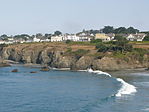Mendocino County, California
| Mendocino County, California | ||||||||
|---|---|---|---|---|---|---|---|---|
| County | ||||||||
| County of Mendocino | ||||||||
Images, from top down, left to right: The community of Mendocino, the historic Grace Hudson Sun House, Point Arena Lighthouse, the Chandelier Tree, the "Skunk Train", A beach in MacKerricher State Park
|
||||||||
|
||||||||
| Nickname(s): "Mendo" | ||||||||
 Location in the state of California |
||||||||
 California's location in the United States |
||||||||
| Country |
|
|||||||
| State |
|
|||||||
| Region | California North Coast | |||||||
| Incorporated | February 18, 1850 | |||||||
| County seat | Ukiah | |||||||
| Largest city | Ukiah | |||||||
| Government | ||||||||
| • Body | Mendocino County Board of Supervisors | |||||||
| Area | ||||||||
| • Total | 3,878 sq mi (10,040 km2) | |||||||
| • Land | 3,506 sq mi (9,080 km2) | |||||||
| • Water | 372 sq mi (960 km2) | |||||||
| Highest elevation | 6,958 ft (2,121 m) | |||||||
| Population (April 1, 2010) | ||||||||
| • Total | 87,841 | |||||||
| • Estimate (2015) | 87,649 | |||||||
| • Density | 23/sq mi (8.7/km2) | |||||||
| Time zone | Pacific Time Zone (UTC-8) | |||||||
| • Summer (DST) | Pacific Daylight Time (UTC-7) | |||||||
| Area code | 707 | |||||||
| Website | www |
|||||||
Mendocino County is a county located on the north coast of the U.S. state of California. As of the 2010 census, the population was 87,841. The county seat is Ukiah.
Mendocino County comprises the Ukiah, CA Micropolitan Statistical Area. It is located north of the San Francisco Bay Area and west of the Central Valley.
The county is noted for its distinctive Pacific Ocean coastline, Redwood forests, wine production, microbrews, and liberal views about the use of cannabis and support for its legalization. It is estimated that roughly one-third of the economy is based on the cultivation of marijuana.
The notable historic and recreational attraction of the "Skunk Train" connects Fort Bragg with Willits in Mendocino County via a steam-locomotive engine, along with other vehicles.
Mendocino County was one of the original counties of California, created in 1850 at the time of statehood. Due to an initially minor white American population, it did not have a separate government until 1859 and was under the administration of Sonoma County prior to that. Some of the county's land was given to Sonoma County between 1850 and 1860.
The county derives its name from Cape Mendocino (most of which is actually located in adjacent Humboldt County), which was probably named in honor of either Antonio de Mendoza, Viceroy of New Spain, 1535–1542 (who sent the Juan Rodríguez Cabrillo Expedition to this coast in 1542), or Lorenzo Suárez de Mendoza, Viceroy from 1580 to 1583. Mendocino is the adjectival form of the family name of Mendoza.
...
Wikipedia







